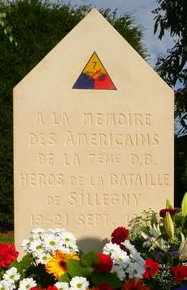
To the memory of the Americans of the 7th Armored Division
heroes of the Battle of Sillegny, 19-21 Sept. 1944
We Remember You

On September 19, 2009, a new monument was dedicated in ceremonies at Sillegny, France, as a memorial to the many men of the U. S. 7th Armored Division who fought in the town and its immediate vicinity. This web page contains information about those ceremonies.
Regretfully, due to health and financial reasons, no official representative of the 7th Armored Division Association was able to attend the ceremonies. However, Association President Edward Kaminski sent the following remarks which were read at the ceremonies by Elisabeth Gozzo.
|
President of the U. S. 7th Armored Division Association, for the Dedication of the Memorial at Sillegny, France September 19, 2009 Thank you to all who are here. I'd like to say also a special word of thanks for those who are responsible for this memorial, for those who researched the events and for those who conceived and designed the memorial and built it. Today, we are dedicating this memorial in memory of all the soldiers of the U. S. 7th Armored Division and attached elements who fought heroically in and around Sillegny. Sixty five years ago on this day, September 19, 1944, this peaceful place was the center of a brutal battle that took many American lives, that left many others suffering from wounds for the rest of their life, and that caused lasting grief and hardship in American families back in the United States. On that day sixty five years ago today, the Hell that is pictured on the frescoes of the walls within the church of Sillegny was a vivid reality outside those walls. War is indeed Hell on Earth. Those men who fought here knew that beyond any doubt. But their fight was to end that Hell, no matter the personal cost to themselves. In World War II, American soldiers left their family, friends and homes to help to defend freedom for the people of Europe. We are dedicating this memorial in memory of those men who fought here, so that all succeeding generations will know how great the sacrifices and devotion of those veterans were, and how precious freedom and peace are. Let me tell just two stories, so as to bring to life today, so many years later, the reality of what happened here on September 19, 1944. Private First Class (Pfc.) Louis Kay of Alicia, Arkansas attacked from the woods to the west. His Company C of the 38th Armored Infantry Battalion (C/38 AIB) attacked across the open field that is now between the rue de Neubourg and the D-67 road. This field had been heavily mined, and Louis Kay was seriously wounded when he set off a mine. His buddy Pfc. William Hennessey of North Tarrytown, New York moved to help him. 38 AIB medic Private (Pvt.) Elias Santillanes of Albuquerque, New Mexico also came to help. Sixty years later, in 2004, surviving C/38 veteran Hugh Hays of Effingham, Illinois told the rest of the story: “The enemy dropped one artillery shell behind them, killing both Hennessey and [Santillanes]. I saw it happen.” Louis Kay was also killed. And there the three men’s bodies remained, unburied, above ground, in a mine field too dangerous to permit recovery, exposed to further artillery, exposed to the elements of Nature. They were not recovered until 20 months later, in April 1946, after the mine field had finally been removed. Louis Kay now rests at St. Avold. William Hennessey and Elias Santiallanes rest at home. Also on that fateful day, September 19, 1944, Company A of the 38th Armored Infantry Battalion attacked from the woods toward Sillegny, along the south side of what is now the D-67 road. Staff Sergeant Peter Gorman, now of Odenton, Maryland, led his squad in the attack. A German soldier hid in a covered hole in the ground, and after S/Sgt. Gorman had passed by the hole, the German shot up at him. The bullet entered the right side of Peter Gorman’s back just above the belt line and traveled up through part of his kidney and other organs. To this day, the wound causes Peter Gorman pain. And the track of the bullet through his body is clearly visible in x-rays. These heroic American soldiers are among those you honor today and for all days that this memorial will stand. Constructed of materials that will survive the elements and the passage of time, the creators of this memorial have honored well the courage and sacrifice of those men. In our routine lives in an age of peace, it is easy to forget just how horrible things were. We fret about things that are trivial in comparison to the problems of 1944. Fifty years from now, some school child who has passed this memorial every day will stop and decide that it is time for him or her to know what this memorial is all about. And they will learn of the Hell that was here. I ask you to pause for a moment of silence, now and whenever you come to this memorial, in honor of those men who fought here to end that Hell. The world is a better place because of them. |
|
Active overview of all pages at the 7th Armored Division web site